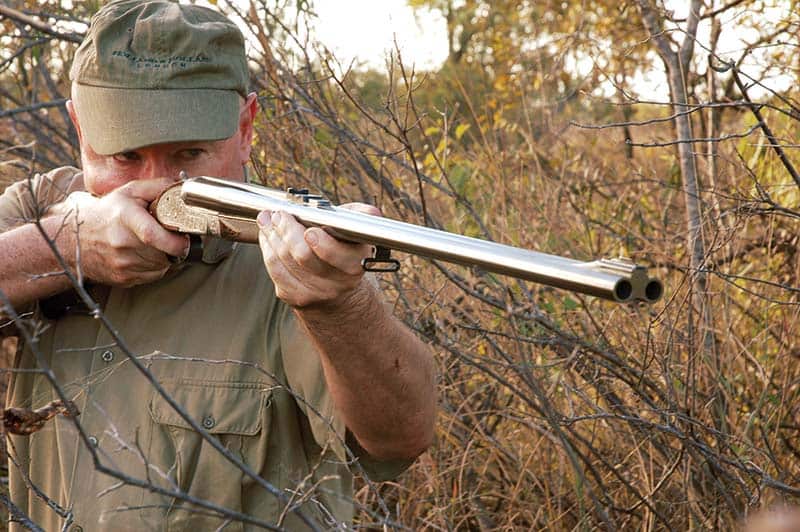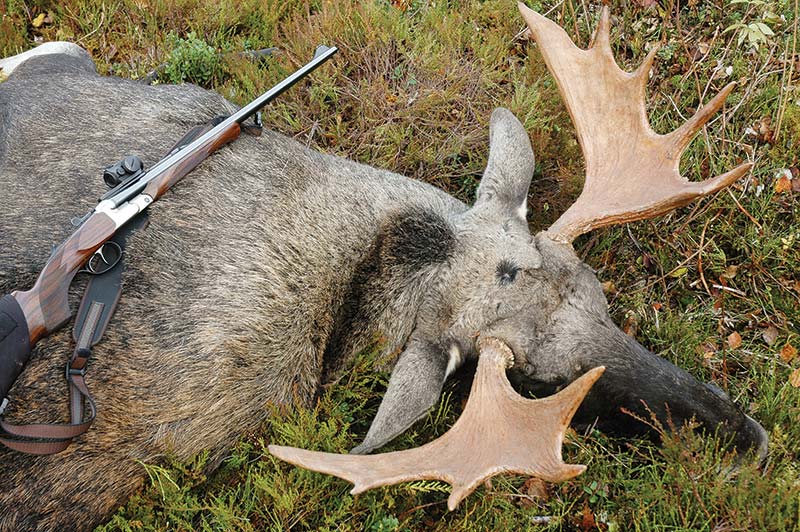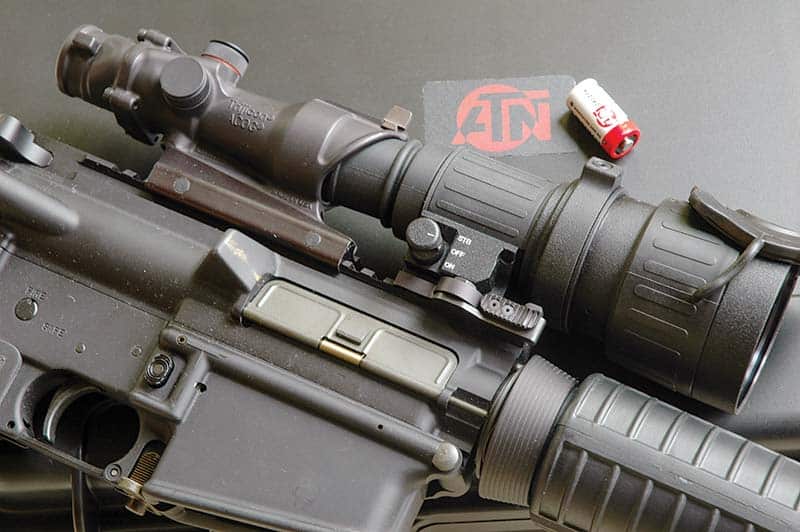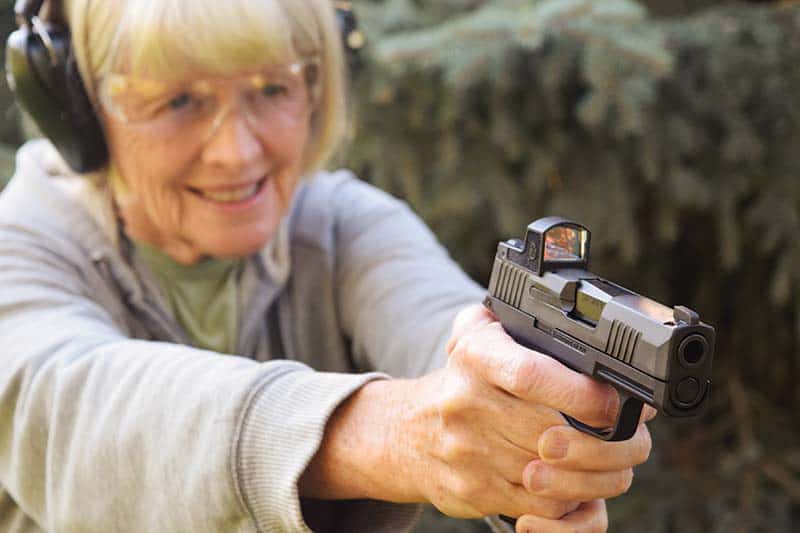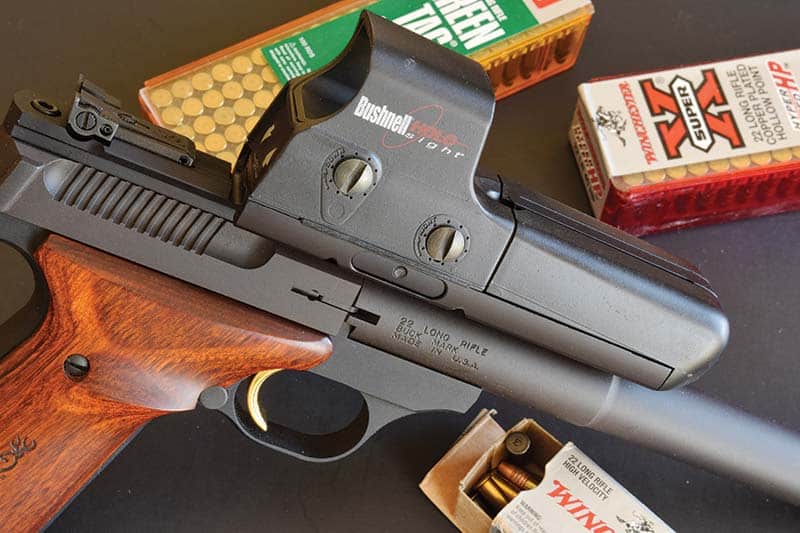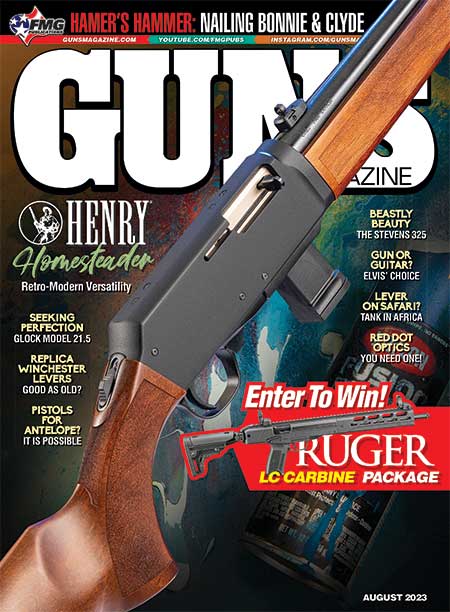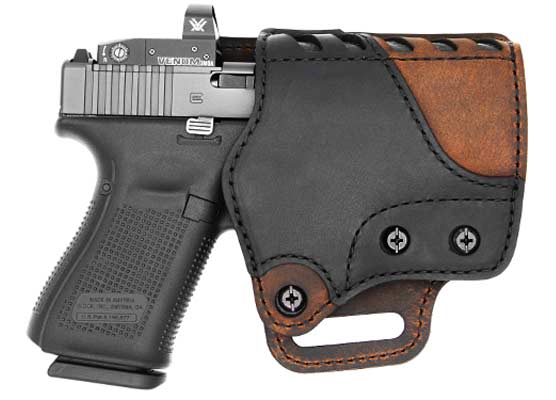More On Dots
Not Classic, But Effective
In 1900, Irish optics engineer Sir Howard Grubb patented his “Collimating-Telescope Gun-Sight.” A reflecting surface projected an adjustable reticle to the shooter’s eye. It may have been the first reflex sight.
Seventy-five years later, Gunnar Sandberg of Sweden developed his “single-point sight.” A shooter looked into it with one eye; the other eye saw a dot on the target. Sandberg founded Aimpoint to build his sight. The compound front lens of a modern Aimpoint sight eliminates parallax by bringing the dot to the eye in a path parallel with the sight’s optical axis. The bullet hits where the dot appears, whatever the eye position.
The New Standard
Early red dot sights got a cool reception but lighter weight, improved adjustments, dials to pair brightness with light conditions and longer battery life — to 50,000 hours! — have since boosted their fortunes.
Open reflex sights emerged as Aimpoint’s closed versions became smaller, lighter, sturdier. Both types have limitless eye relief and draw little battery power. The reticle is an LED image reflected from a glass screen. A closed sight yields the brightest dot and deflects weather and obstructions. An open reflex sight is more compact and nearly weightless. (Trijicon’s RMR and Leupold’s DeltaPoint Pro scale weigh just 2 ounces, Holosun and Burris tube models about 5.) Not all reflex sights work with attachments.
Not that red dots excel at every task. Early promotions urged their use on clay target guns. I tried a shotgun so equipped and repeatedly whiffed high incomers. After a lucky hit, I held the dot the same for later targets and shattered them but I was no longer pointing — I was aiming, as if correcting with a rifle after finding an off-center hold delivered hits. A red dot sight’s main failing on a bird gun is its position well above the bore. Unless the comb is built up, you can lose cheek contact. One guaranteed way to miss with a shotgun is to lift your head off the stock.
To my surprise, busting birds left-handed, once no easier for me than scooping peas with a knife, was suddenly possible. Aiming instead of pointing, all I had to do was find the dot and put it where a shot brought a hit. But these were slow targets on predictable paths. Grouse rocketing through alders and wood ducks sifting on a tail wind through swamp timber defy aim.
Double rifles for dangerous game are sprouting red dot sights now, a nod to aging eyes that can’t quickly fit a small silver bead in a fine rear notch. Like a shotgun stock, the safari rifle must place the eye on the sight axis without a struggle. Combs on doubles are traditionally tailored for aim with iron sights low on the rib. A stock or a pad lifting lifts your cheek to match the higher axis of a red dot sight will speed your aim. You’ll shoot more comfortably too, if stiff recoil doesn’t give the comb a running start into your chops.
Some shooters fault a red dot sight for its low or non-existent magnification. While it can’t best a target scope for precision at a distance, an illuminated dot delivers game-killing accuracy at 100 yards, with magnification even farther. The operative qualifiers: dot size and brightness.
Keys To Success
Common size options are 3 and 6 minutes of angle. A 3-minute dot has long been standard in 2 ½x, 3x and 4x rifle scopes. It appears small in a 1x reflex sight. Illuminated, it catches your eye but it’s bad business to choose a tiny dot, then crank the brightness up to see it. At 3x, a 3-minute dot seems to me about right. In a 1x reflex sight, a 6-minute dot is better. It’s much easier to see but subtends only 12″ at 200 yards — about 3/4 the depth of a deer’s chest. In the wooded country most whitetails prefer, 200 yards is a relatively long shot.
Many hunters new to red dots dial the brightness to or near the top level. In dim light or shadow, a little illumination is enough! Save those top settings for sunny days when background glare competes with the glow of the dot. A bright dot in dark timber has the effect of an automobile headlamp at night. It hides what’s behind and a good deal of what’s around it. Brilliance produces a halo about its source. As your eye’s pupil constricts to limit light, it is less able to resolve details of what isn’t hidden by that halo. The best illumination setting is the lowest clearly defining the dot — anything more makes the dot appear bigger, reducing precision while impairing your view of the target.
A red dot helps even when a black reticle is easily defined. Once, in a gap in thick cover, I spied pieces of moose shifting back and forth. Steadying the rifle against a tree, I held the red dot on black hair and waited. At last an antler appeared, then a hump. The bull collapsed to my shot. On another hunt, rain came so insistently, I could keep nothing dry. A moose appeared, its image blurred by the water streaming across the sight’s lens. But the dot was bright enough to make the short shot easy.
Tolerance
While batteries in general leave me cold, I’ve come to accept them in red dot sights. One tiny 3V camera battery, hidden and all but weightless, can power a sight for thousands of hours. Some illuminated reticles switch themselves off after periods of non-use, or automatically adjust brightness to conditions.
A growing assortment of rifle scopes now feature illuminated dots or center sections on otherwise traditional reticles. These make sense if you want illumination but also the options of a black aiming point and high magnification for precise shots at distant targets in good light. Of course, these are long, heavy sights, many with objective bells big enough to require mid-height (or higher) scope rings. And they cost more than even top-end red dot sights.
To my mind, rifles and slug guns bound for places where most shots come inside 150 yards are as well-equipped with red dot sights as with the 2 ½x and 3x scopes popular and effective for most of a century. They’ve become easier to mount on rifles, shotguns and big handguns, and deliver a clear edge in poor light. Reflex models weighs much less than rifle scopes in rings. They offer unlimited eye relief and are more forgiving as regards lateral eye position.
Red dot sights still don’t pass the cosmetic test on “classic” bolt rifles and single-shots, let alone on fine doubles. They look out of place on the exposed-hammer lever-actions we’ve fondly labeled “deer rifles.” Viewed in the cold light of utility, though, they deserve more plaudits than they get.
